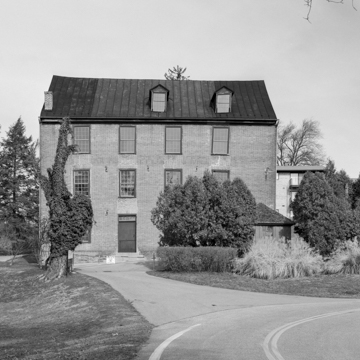You are here
Owings Upper Mill
Owings Upper Mill is the oldest and largest surviving grist mill in Baltimore County, and a good example of the merchant mills erected during the post–Revolutionary War investment boom. Built by enterprising merchant and Revolutionary patriot Samuel Owings Jr., the mill is representative of a leading industry in Maryland and the source of Baltimore’s nineteenth-century rise as a prominent port city. While the state’s early economy was based primarily on the tobacco trade, the subsequent depletion in soil quality led many to seek solutions such as the use of new fertilizers, crop rotation, and the planting of alternatives to tobacco, predominately wheat. Increased grain production sparked the growth of local mills, which were also needed for grinding fertilizers from plaster and bone. Grist mills, such as Owings Upper Mill, helped to transform the rural landscape and became a major contributor to Maryland’s newfound prosperity in the country’s early years.
Owings Upper Mill is a fairly plain, vernacular interpretation of the Federal style. It is well-built of brick construction and includes a 50 x 60-foot main block with a center pavilion on the north facade. Its interior is still lit by its original twelve-over-twelve sash windows. On the south elevation, the brick is laid in Flemish bond; on the side and rear elevations, it is laid in English bond. The building rests on a stone foundation and is slightly banked so that its south front is three-and-a-half stories and the north is two and a half; ground-level entries are on both elevations. The principal or visitor entry on the south facade has two transomed doorways. The half story is lit by dormers. The rear was the working side of the mill; its center pavilion houses loading doors and includes an upper-story hoist covered by a gabled hood. It is the only known extant example of a brick loading pavilion in Maryland. Although most of the grinding equipment has been removed, a number of pulleys, hoists, bins, a corn sheller, smut machine, balance scales, flour packer, and belt elevator system for moving flour are still in place. Moreover, Owings Upper Mill’s exposed framing provides an opportunity to examine the millwright’s building skill, particularly the massive posts fastened with wood pegs.
This was the last of a series of three or four mills built by Owings on this site. The “upper mill” appears on the 1798 tax list along with two other mills and 1,775 acres of land. In addition to his milling business, Owings was a county commissioner and member of the Maryland General Assembly, and he served as a colonel during the Revolutionary War. In 1848 the mills were purchased by the Groff brothers, who sold out to the youngest, Benjamin Franklin Groff, in 1856; it was during this period that the site was renamed Eureka Mill. The Groffs milled for both general production and the custom trade, which is work done for a portion of the ground grain rather than for cash. A frame section was later added to one side of the center pavilion. The Groff family also added a brick dwelling house and a barn to the property. When flour production stopped in 1906, most of the milling equipment was removed and the mill became a fuel and feed store. It remained in the Groff family until 2006.
References
McGrain, John. Grist Mills in Baltimore County, Maryland. Towson, MD: Baltimore County Public Library, 1980.
McGrain, John. “Owings Upper Mill, Eureka Mill,” Baltimore County, Maryland. National Register of Historic Places Inventory–Nomination Form, 1976. National Park Service, U.S. Department of the Interior, Washington, DC.
Sharp, Henry K., “Ellicotts Lower Mills Sites,” Howard County, Maryland. Maryland Historical Trust Survey #HO-73, 1998. Maryland Historical Trust, Crownsville, Maryland.
Sharrer, Terry G. “The Merchant-Millers: Baltimore’s Flour Milling Industry, 1783-1860,” Agricultural History 56, no. 1 (January 1982): 138-150.
Writing Credits
If SAH Archipedia has been useful to you, please consider supporting it.
SAH Archipedia tells the story of the United States through its buildings, landscapes, and cities. This freely available resource empowers the public with authoritative knowledge that deepens their understanding and appreciation of the built environment. But the Society of Architectural Historians, which created SAH Archipedia with University of Virginia Press, needs your support to maintain the high-caliber research, writing, photography, cartography, editing, design, and programming that make SAH Archipedia a trusted online resource available to all who value the history of place, heritage tourism, and learning.















